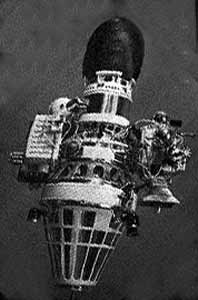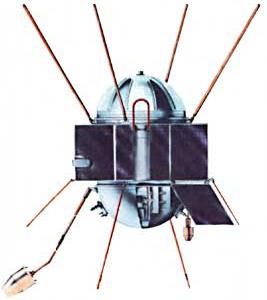Cosmos Series

The Cosmos 60 spacecraft (Credit: Soviet Space Program)

Drawing of the Cosmos 135 spacecraft. (Credit: Soviet Space Program)

Drawing of the Cosmos 461 spacecraft. (Credit: Soviet Space Program)
Cosmos, which is also called Kosmos, is a series of unmanned Soviet and Russian satellites which have been launched from 1962 to the present. There have been nearly 2500 satellites as of 2013. The satellites are not one continuous program, but are used for a broad spectrum of uses from scientific investigation, communications and military reconnaissance. The satellites listed here are ones that have made contributions to high energy astronomy.
Lifetime: March 1962 (first launch, Cosmos 1) - Present
Country (primary): Soviet Union, then Russia
Links to more information
Cosmos 60
Lifetime: March 1965 - March 1965
Primary Science
Cosmos 60 was intended as a lunar probe, the Soviet Union's sixth attempt at a soft-landing on the moon. While the spacecraft made Earth-orbit, it failed to leave orbit for its journey to the moon.
Science Highlights
- Measured the gamma-ray background flux density.
Cosmos 135
Lifetime: December 1966 - April 1967
Primary Science
The study of cosmic dust particles in near-Earth space.
Science Highlights
- Measured the spectrum and time variations of gamma-ray intensity of diffuse cosmic background.
Cosmos 163
Lifetime: June 1967 - October 1967
Primary Science
The study of cosmic dust particles in near-Earth space.
Science Highlights
- Measured the spectrum and time variations of gamma-ray intensity of diffuse cosmic background.
Cosmos 428
Lifetime: June 1971 - July 1971
Primary Science
Cosmos 428 was primarily a military satellite, with X-ray astronomy experiments added to the payload.
Science Highlights
- Detected several discrete X-ray sources that were correlated with previously identified sources observed by Uhuru.
Cosmos 461
Lifetime: December 1971 - February 1979
Primary Science
The primary science of Cosmos 461 was to study micrometeroroids in Earth's vicinity and to conduct gamma-ray astronomy.
Science Highlights
- Detected at least one gamma-ray burst observed by the Vela satellites.
- Measured the diffuse gamma-ray background.
Cosmos 856
Lifetime: September 1976 - October 1976
Primary Science
It is unknown what the primary mission of Cosmos 856 was, but it was likely primarily a military mission. However, it did carry a gamma-ray spectrometer which performed science observations.
Science Highlights
- Surveyed the diffuse gamma-ray sky.
Cosmos 914
Lifetime: May 1977 - June 1977
Primary Science
Cosmos 914 was primarily a low-resolution photographic reconnaissance satellite. However, it did carry a gamma-ray spectrometer which performed science observations.
Science Highlights
- Surveyed the diffuse gamma-ray sky.
Cosmos 1106
Lifetime: June 1979 - June 1979
Primary Science
Cosmos 1106 was primarily intended to perform a study of Earth ice; however, it also carried a gamma-ray spectrometer for celestial studies.


